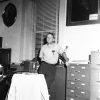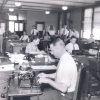calsfoundation@cals.org
Thyra Samter Winslow (1885?–1961)
Thyra Samter Winslow wrote more than 200 stories published between 1915 and 1955 in the heyday of American popular magazines. Her early life in Fort Smith (Sebastian County) provided background for her view of small towns as prejudiced, hypocritical, and suffocating places. She was a principal contributor to Smart Set, with stories in every issue from December 1914 to 1923. Some of her work was collected in books such as My Own, My Native Land (1935), People Round the Corner (1927), Picture Frames (1923, reprinted as Window Panes in 1945), and The Sex without Sentiment (1954).
Published accounts of Winslow’s life are often contradictory. The authoritative work is a doctoral dissertation by Richard C. Winegard, who established Winslow’s biography from published records, Winslow’s own statements, and many interviews with informants in Fort Smith and elsewhere. He wrote, “She was restless, witty, independent, shrewd, kind, utterly mendacious, and sometimes completely dishonorable, and yet she is remembered most for her charm.”
Thyra Samter was born in Fort Smith on March 15, probably in 1885 or 1886, to Sara Harris Samter and Louis Samter. Her father operated a dry-goods store in Fort Smith. The family belonged to the Jewish community. She attended the public schools there, and she wrote a column in 1907 in the society pages of the Fort Smith Southwest American. She briefly attended the University of Missouri in Columbia but returned to Fort Smith.
In 1909, she went to Chicago, Illinois, where she worked in vaudeville theater and as a journalist. She married John Seymour Winslow, a writer, in 1912. They had no children.
In 1914, one of her stories, “In the Case of Lou Terry,” was published in Smart Set, a New York magazine edited by H. L. Mencken and George Jean Nathan. Around 1918, the Winslows moved to New York, where she contributed regularly to Smart Set through 1923. After Mencken and Nathan left Smart Set, Winslow continued to write for other magazines, including Century, American Mercury, Cosmopolitan, and Redbook. She wrote for The New Yorker, then a new magazine of the Jazz Age, including many pieces about Arkansas in “Talk of the Town.” A collection, Picture Frames, was published in 1923.
The Winslows divorced in 1927, and Thyra married Nelson Waldorf Hyde, an engineer, in December 1927. The couple separated soon afterward, though they remained married for ten years.
In 1935, Doubleday published My Own, My Native Land, with stories that had originally appeared in The New Yorker, drawing from her life in Fort Smith. Following the success of this work, she went to Hollywood to write the screenplay for She Married Her Boss, starring Claudette Colbert and Ronald Colman. She remained there adapting stories for other films until 1937, when she returned to New York and continued writing for popular women’s magazines. She also wrote diet books, including Think Yourself Thin (1951). Her literary output diminished in the last years of her life, and she wrote “true confessions” for pulp magazines and drama reviews for Gotham Guide, a weekly handout for tourists.
In 1960, she visited Fort Smith for the last time. Later that year, she was paralyzed by a fall and remained hospitalized until her death on December 2, 1961. Her funeral was at St. Patrick’s Cathedral in New York—she had converted to Catholicism during her last illness—and she is buried in the Gate of Heaven Cemetery in Westchester County, New York.
Winslow’s fiction evinces several traits of American local color and realism. Many stories expose the hypocrisy, prejudice, and carefully maintained social structures of both small town and urban life. She was particularly adept at portraying women of every social class, often in an unfavorable light. Money, especially the pursuit of it as a means to happiness or status, is an important theme throughout her work.
Her spare journalistic style somewhat resembles Ernest Hemingway’s, with short factual statements in simple declarative sentences. The influence of Theodore Dreiser is evident in her portrayal of the “common man” or woman of the American lower-middle class. She flourished in the age of popular magazines with their constant demand for fiction. As those magazines declined, the market for Winslow’s work died away.
For additional information:
Simpson, Ethel C. “Thyra Samter Winslow’s Magazine Fiction.” Arkansas Historical Quarterly 79 (Summer 2020): 116–132.
Thyra Samter Winslow Papers, 1900–1970. Special Collections. University of Arkansas Libraries, Fayetteville, Arkansas.
Winegard, Richard Clarence. “Thyra Samter Winslow: A Critical Assessment.” PhD diss., University of Arkansas, 1971.
Ethel C. Simpson
University of Arkansas, Fayetteville
 Early Twentieth Century, 1901 through 1940
Early Twentieth Century, 1901 through 1940 Literature and Authors
Literature and Authors Mass Media
Mass Media




Comments
No comments on this entry yet.